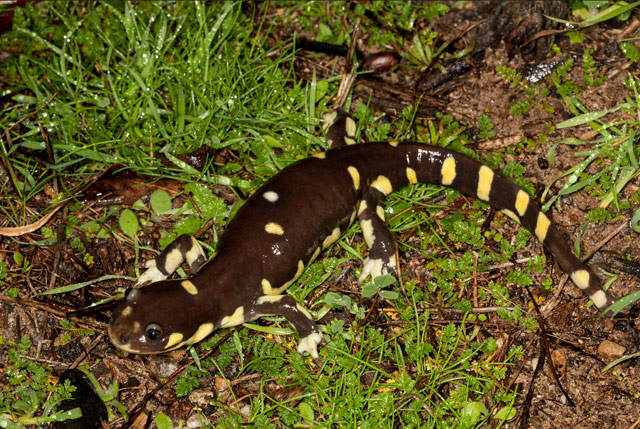Tiger Salamander Recovery Plan Released
Northern Santa Barbara County Endangered Species Needs Vernal Pools and Squirrel Burrows to Thrive

On rainy nights in east Santa Maria, California tiger salamanders are known to cross Dominion, Foxen Canyon, and Orcutt-Garey roads as they trundle from underground burrows to vernal pools to breed. Researchers tend to discover about half of the roving 6- to 10-inch adults after they’ve been hit by cars. Vehicle strikes are only one of the threats to Ambystoma californiense, which has been listed as endangered since 2000. This type of salamander exists only in northern Santa Barbara County — similar ones are found in Monterey and Sonoma areas, but are genetically distinct — in six geographic areas where they form “metapopulations.” Federal Fish & Wildlife issued a Recovery Plan on December 12 for Santa Barbara County’s tiger salamanders that is intended to boost the overall population to healthy numbers by 2045 at an estimated cost of $181 million.
Among the criteria to delist the creature — a dark-skinned “mole” salamander with yellow or white markings — is the permanent preservation of at least four of each group’s known breeding ponds and 1,629-plus acres of contiguous and functional habitat surrounding each. The creature lives underground in squirrel or gopher burrows, eating a diet of worms and insects. Pools of water become essential to its life cycle when the salamanders emerge during wet weather to travel as far as a mile to find a pond — often the one they were born in — and breed, an event that can occur every two to eight years. Females lay eggs that take 10-25 days to hatch, faster when the weather is warmer, and the tadpoles can take up to four months to turn into the blunt-nosed salamanders.
Weighing against the tiger salamander is the chief North County industry, agriculture, which can disturb burrows, ground cover, and pooling water. Also, native predators abound — from great blue herons to western pond turtles and garter snakes, not to mention bigger salamanders — and so do non-natives like bullfrogs, mosquitofish, and “waterdogs,” a salamander used as bait. However, as many as 60 ponds have been identified as breeding ponds, from the Santa Maria to the Santa Rita valleys, both vernal pools and stock ponds. Most exist on private property and were discovered inadvertently during land development surveys.
The salamanders’ reliance on two types of habitat and somewhat irregular breeding cycle complicate their survival. The Recovery Plan indicates that large quantities of acreage would ensure vernal pools reappear after the rains and that enough undisturbed, open land surrounding them would allow the salamanders to reach the ponds without crossing roads or railroad tracks. Currently, three formal conservation easements exist: 853 acres at La Purisima Conservation Bank, 160 acres at the Anderson easement, and 594 acres at San Lorenzo Ranch. These properties are held by various land trusts. Three more properties have voluntary management plans to benefit the tiger salamander: Los Robles Ranch, Sainz Ranch, and a Scheller trust property near Purisima.


